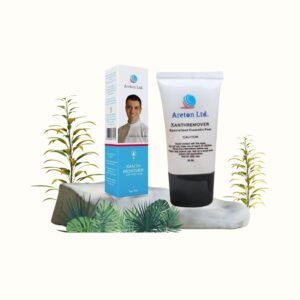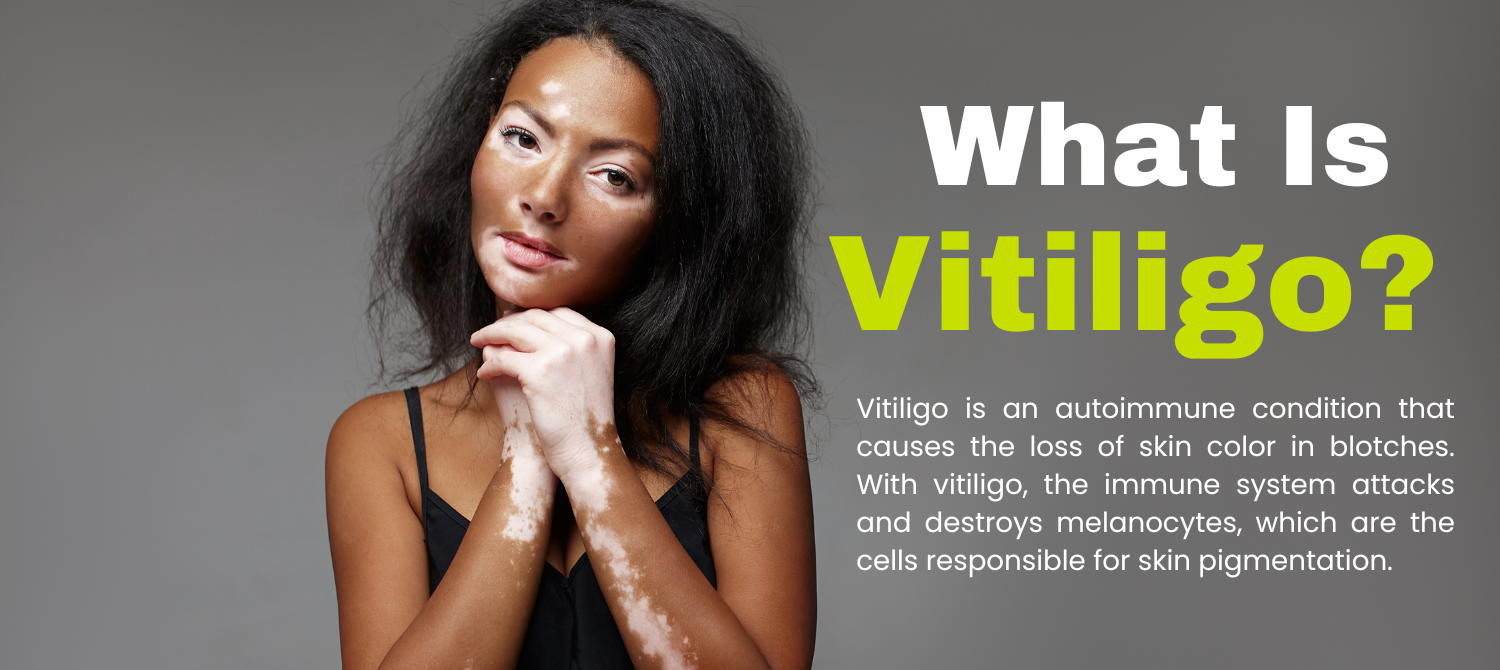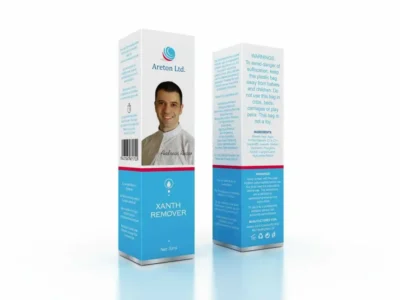What is Vitiligo?
Vitiligo is an autoimmune condition that causes the loss of skin color in blotches. With vitiligo, the immune system attacks and destroys melanocytes, which are the cells responsible for skin pigmentation. When melanocytes are destroyed, the skin loses its color and white patches appear. These patches can occur anywhere on the body, but commonly affect areas like the face, hands, arms, feet, and lips.
The appearance of vitiligo is different for each person. For some, it starts as a small white spot that slowly spreads. Others may experience a more rapid loss of skin pigment resulting in larger patches. The patches may be localized to one part of the body or spread across large areas. The condition is not life-threatening or contagious, but can have emotional and psychological effects due to its visible symptoms affecting appearance. There is no cure for vitiligo, but several treatment options are available to help manage it. The goal of treatment is to stop progression and restore some of the lost skin color.
Symptoms of Vitiligo
The main symptom of vitiligo is the appearance of patchy loss of skin color. The patches of de-pigmented skin are initially small, but often grow and change shape over time. The patches can appear anywhere on the body, but are most commonly seen on sun-exposed areas like the face, neck, hands, arms and lips.
The loss of skin pigment is particularly noticeable on darker skin. The affected skin patches start off as pale white at first. Over time, the white patches may become larger and spread to other areas. The borders of the white patches are often sharply defined at first, but may become irregular over time. The white patches may also appear on hair, the inside of the mouth or nose, and even the eyes.
In addition to white patches on the skin, people with vitiligo may experience premature graying of scalp hair, eyelashes, eyebrows and beard. Loss of color in the tissues lining the inside of the mouth and nose, and the retina of the eyes is also possible.
What Causes Vitiligo?
Vitiligo is caused by the loss of melanin, the pigment that gives skin its color. Melanin is produced by melanocytes, specialized cells found in the epidermis (outer layer of the skin). In vitiligo, the melanocytes are destroyed, leading to depigmented patches on the skin.
The exact cause of melanocyte destruction is unknown, but research suggests it’s an autoimmune disorder. This means the body’s immune system mistakenly attacks the melanocytes. Antibodies directed against pigment cells have been found in the blood of people with vitiligo.
Other theories include oxidative stress damaging the melanocytes, and a genetic predisposition to vitiligo. Triggers like sunburn, stress, or exposure to industrial chemicals may also set off the condition in susceptible individuals. Overall, vitiligo is considered a multifactorial disease with genetic, immune, and environmental factors involved.
Diagnosing Vitiligo
Diagnosing vitiligo involves a physical exam, medical history, and blood tests.
Physical Exam
During a physical exam, a dermatologist will examine the skin, looking for depigmented patches. They will note the location, size, shape and extent of the discoloration. The doctor will also check for signs of inflammation or if the skin feels different in the discolored patches. They will look for poliosis, which is the loss of color of the hair in those areas.
Medical History
The dermatologist will take a full medical history, asking about:
- When the discoloration first appeared and how quickly it spread
- If the patches appeared after sun exposure or skin trauma
- If the patient has a family history of vitiligo
- If the patient has any other autoimmune disorders like hyperthyroidism, rheumatoid arthritis or Addison’s disease.
Blood Tests
The dermatologist may order blood tests to check for thyroid issues, diabetes, and other autoimmune disorders. This can help confirm the diagnosis. They may also do a biopsy of the skin.
Conventional Vitiligo Treatment
Conventional medical treatments for vitiligo aim to stop the spread of depigmentation and possibly restore some of the lost skin color. Common approaches include:
Corticosteroid Creams
Corticosteroid creams are often the first line of treatment for vitiligo. These creams help reduce inflammation and may suppress the immune response that destroys melanocytes. Corticosteroids come in varying strengths and are applied directly to depigmented patches once or twice daily. Results can take weeks or months to appear. Side effects may include skin thinning or streaking.
Light Therapy
Light therapy exposes the skin to UVA or UVB light under medical supervision. The ultraviolet light activates melanocyte stem cells, encouraging melanin production. Phototherapy is often used along with other vitiligo treatments. Exposing the entire body can help prevent the spread of depigmentation. Light boxes or laser treatments may be used. Protective eye goggles are worn to avoid eye damage from the bright light.
In some cases, a skin graft can be used to restore color to vitiligo spots. During this surgery, the doctor removes a thin layer of pigmented skin from an unaffected area. They then transplant it to cover the white patch. Possible donor sites include the gluteal region. The color match may not be exact, but results can be long-lasting. Healing can take several weeks.
Lifestyle Changes for Vitiligo
Making certain lifestyle adjustments can help manage vitiligo symptoms. While lifestyle changes alone won’t cure vitiligo, they can minimize spreading and improve quality of life.
Sun Protection
It’s essential for vitiligo patients to protect their skin from sun exposure. UV radiation can worsen depigmentation and cause sunburns on discolored patches. Wear sunscreen, protective clothing, and wide-brimmed hats outdoors. Avoid prolonged sun exposure, especially during peak hours. Seek shade whenever possible.
Healthy Diet
Eat a balanced diet with plenty of antioxidants to support skin health. Foods high in vitamin C, vitamin E, zinc, and copper like fruits, vegetables, nuts, seeds, and legumes help protect against free radical damage. Some research also suggests vitamin D and B12 supplementation could slow vitiligo progression.
Stress Management
Stress may exacerbate vitiligo for some patients. Try relaxation techniques like meditation, yoga, deep breathing, and massage. Make time for hobbies and self-care. Consider counseling for mood disorders like anxiety or depression. Getting adequate sleep, exercise, and social connection also aids stress management.
 Rated 0 out of 5¡A la Venta!Add to basket
Rated 0 out of 5¡A la Venta!Add to basket$50.99Original price was: $50.99.$39.99Current price is: $39.99.
Coping with Vitiligo
Living with vitiligo can take an emotional toll and impact self-esteem. The change in skin pigmentation and appearance can be difficult to accept. Some coping tips include:
Focus on self-care – Treat yourself with compassion and kindness. Engage in activities you enjoy and find relaxing. Surround yourself with a support system of loving friends and family.
Join a support group – Connect with others dealing with vitiligo. Support groups provide a sense of community, helpful advice and allow you to share your experiences. The Vitiligo Support International group has chapters across the globe.
Consider counseling – A therapist can help you process your emotions, boost self-esteem and develop healthy coping mechanisms. Cognitive behavioral therapy in particular may help change negative thought patterns.
Avoid triggers – Identify situations that cause anxiety or emotional distress related to your vitiligo. Avoiding these triggers can help minimize their impact.
Focus on the positive – Remind yourself that vitiligo doesn’t define you. You have many wonderful qualities beyond your skin. Surround yourself with people who appreciate you for you.
Take good care of your skin – Follow your doctor’s treatment plan for managing vitiligo. Proper skin care can help improve the appearance of discoloration.
The emotional impact of vitiligo is real. Seeking social support, counseling and focusing on self-care can help you learn to embrace yourself while coping with the condition.
Vitiligo in Children
Vitiligo can be especially challenging for children. The visible skin changes caused by vitiligo can lead to emotional distress, anxiety, and depression in kids.
Children with vitiligo are often teased and bullied about their appearance. This can take a major emotional toll and negatively impact their self-esteem and confidence. Some children may refuse to go to school or avoid social situations due to embarrassment about their skin.
It’s important for parents to have open conversations with their kids about vitiligo, offer emotional support, and work with schools to address bullying. Connecting children with vitiligo support groups can also help them feel less alone.
Treating vitiligo in children comes with its own set of challenges. Some treatments like phototherapy require frequent visits to the doctor’s office, which can disrupt school and activities. Topical creams need to be applied daily, which requires diligence.
Overall, managing expectations around treatment effectiveness and improvement is especially important for children. While some kids do see their vitiligo improve with treatment, it often takes time. Supporting self-esteem, confidence and addressing emotional health is key.
Home Remedies for Vitiligo
In addition to conventional medical treatments, there are some natural and home remedies that may help manage vitiligo. However, always consult your doctor before trying any new remedies, as some may interact with medications or cause side effects.
Supplements
Some supplements that show promise for vitiligo include:
Vitamin D: Vitamin D deficiency may be linked to vitiligo. Taking a vitamin D supplement can help restore normal levels. Typical dosage is around 2000 IU per day.
Vitamin B12: Vitamin B12 helps reduce depigmentation and stimulates melanin production. Take 500-1000 mcg daily under medical supervision.
Ginkgo biloba: Ginkgo is an antioxidant that may help manage spreading of white patches. Take 120-160 mg of standardized extract daily.
Zinc: Zinc supplements may help repigment skin. Take up to 50 mg daily under medical supervision.
Folic acid: Folic acid helps produce melanin. Take 400-800 mcg daily.
Herbs
Some herbs used in traditional medicine for vitiligo include:
Ginkgo biloba: In addition to supplement form, ginkgo leaf extracts can be applied topically. Look for standardized extract creams.
Bacopa: Bacopa monnieri is an Ayurvedic herb that may stimulate melanin production. Take 300 mg daily or apply extracts topically.
Red clover: Red clover contains antioxidants that may help manage vitiligo spread. Apply extracts topically or drink as tea.
Ginseng: Both American and Korean ginseng have immune-boosting and skin-healing properties. Take 100-200 mg capsules daily.
Essential Oils
Some essential oils to try for vitiligo management include:
Tea tree oil: Has antifungal and anti-inflammatory properties that may help treat patches. Dilute with carrier oil before applying.
Bergamot oil: Contains antioxidants and may help stimulate melanin production. Apply diluted oil to patches.
Geranium oil: Improves skin cell regeneration and blood circulation. Use a few drops mixed with lotion.
Rosemary oil: Stimulates melanin and may repigment vitiliginous skin when applied topically. Always dilute first.
Soaps
Our line of natural skin care soaps contains ingredients that may aid in managing vitiligo:
Soaps with oils like coconut, olive, almond, and jojoba moisturize and nourish the skin.
Oatmeal soaps exfoliate dead skin cells and reduce inflammation.
Tea tree, neem, and turmeric soaps have antifungal and healing properties.
Sandalwood soaps may stimulate melanin production.
Use our vitamin-enriched soaps as part of your daily skin care routine. Avoid harsh soaps and scrubbing affected areas.
Our Vitiligo Skin Care Soaps
Our natural skin care soaps are specially formulated to help manage vitiligo symptoms. The gentle formula contains ingredients like oatmeal and aloe vera to soothe irritated skin and turmeric to reduce inflammation.
The soaps are made with plant-based oils like olive, coconut, and castor that moisturize the skin without clogging pores. Vitamin E provides antioxidant protection while calendula has healing properties.
To use, lather the soap with water and gently massage onto affected areas. The mild cleansers will remove impurities without stripping the skin. Rinse thoroughly. For best results, use daily in place of regular soap. The soothing ingredients will help restore moisture and support skin health.
With regular use, our vitiligo soaps can help reduce itching and burning, improve skin tone and texture, and minimize the spread of depigmentation. The natural formula is free of harsh chemicals, fragrances, and dyes that can further irritate sensitive skin prone to vitiligo. Discover the difference our thoughtfully crafted soaps can make for your skin.
 Rated 0 out of 5¡A la Venta!Add to basket
Rated 0 out of 5¡A la Venta!Add to basket$10.00Original price was: $10.00.$5.99Current price is: $5.99. Rated 0 out of 5¡A la Venta!Add to basket
Rated 0 out of 5¡A la Venta!Add to basket$10.00Original price was: $10.00.$5.99Current price is: $5.99.




